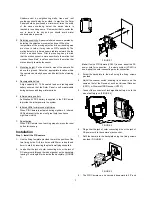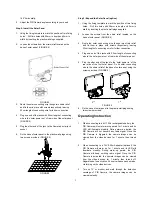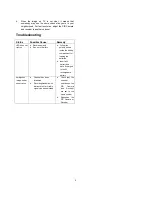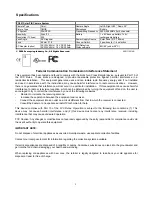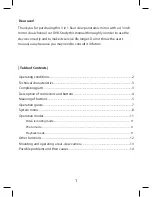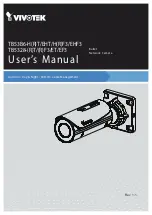
5
Specifications
VC401 Solar PIR Camera System
Camera Type
Color
Camera Angle
Left & Right
±
80°, Down 50°
Picture Type
CMOS
Microphone
Build in
TV System
PAL/NTSC
Transmitting Frequency 2400~2483MHz (for 4 channels)
Sensitivity 3Lux
f1.2
Resolution (TV lines)
250
Battery
1 x 9V back up battery, 1x 6V
rechargeable battery
Lens Angle
56° Diagonal
Power Supply Source
Solar Panel (110*160mm)
Lens
6.0mm F1.8
Channel Switch
4 positions for 1~4 selection
AC Adapter (option)
AC120V 60Hz / 7.5V DC 300mA
AC230V 50Hz / 7.5V DC 300mA
PIR Detect ion
Distance/Angle
8M/80° (under 28°C)
© 2006 Everspring Industry Co., All Rights Reserved.
A501110214R
Federal Communication Commission Interference Statement
This equipment has been tested and found to comply with the limits for a Class B digital device, pursuant to Part 15 of
the FCC Rules. These limits are designed to provide reasonable protection against harmful interference in a
residential installation. This equipment generates, uses and can radiate radio frequency energy and, if not installed
and used in accordance with the instructions, may cause harmful interference to radio communications. However,
there is no guarantee that interference will not occur in a particular installation. If this equipment does cause harmful
interference to radio or television reception, which can be determined by turning the equipment off and on, the user is
encouraged to try to correct the interference by one of the following measures:
-
Reorient or relocate the receiving antenna.
-
Increase the separation between the equipment and receiver.
-
Connect the equipment into an outlet on a circuit different from that to which the receiver is connected.
-
Consult the dealer or an experienced radio/TV technician for help.
This device complies with Part 15 of the FCC Rules. Operation is subject to the following two conditions: (1) This
device may not cause harmful interference, and (2) this device must accept any interference received, including
interference that may cause undesired operation.
FCC Caution: Any changes or modifications not expressly approved by the party responsible for compliance could void
the user's authority to operate this equipment.
IMPORTANT NOTE:
Do not dispose of electrical appliances as unsorted municipal waste, use separate collection facilities.
Contact your local government for information regarding the collection systems available.
If electrical appliances are disposed of in landfills or dumps, hazardous substances can leak into the groundwater and
get into the food chain, damaging your health and well-being.
When replacing old appliances with new once, the retailer is legally obligated to take back your old appliance for
disposal at least for free of charge.


